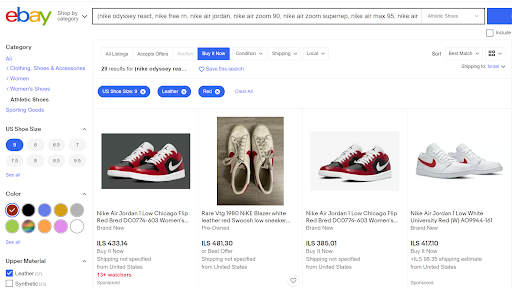Feed optimization for site search & navigation

Feed optimization for site search is really important because in most search queries, shoppers use different terms and keywords that describe the product they wish to buy. This information is passed on with a product feed, and for the site search to function properly, it must be accurate and complete.
Almost all online shoppers begin their shopping journey with a search. This helps them focus on the products they are looking for. So, for example, they search for “black leather jacket”, expecting to find just that, but instead, some of the results do not match the search query. The insistent shoppers will give it another try, searching instead for “leather coat”. Unfortunately, in many cases this query will bring them to a “No Results” screen and in a more optimal scenario will show less relevant items .
Not yet giving up, the tenacious customer now chooses to give the filters a go. For the “Type” attribute, they select the “Jacket” value, and “Black” for the “Color” attribute. The results page shows only a small number of products, none of which is exactly what the customer was looking for. By this point, you cannot blame them for giving up and looking for the product elsewhere. This is a lost sale opportunity, and the worst thing is you do sell black leather jackets of different varieties in your online store! Perhaps just like the one the frustrated customer has been looking for.
So because of poor site search, shoppers cannot find the products they are looking for, which directly leads to lost sales.
In this article, we will discuss the importance of properly constructed site search and how creating good product data improves the shopping experience.
The importance of a good site search
The level of site search has a significant effect on conversion rates in the store. Let’s see why.
Buyers used to high standards
Today’s ecommerce shoppers are very sophisticated and developed very high standards when it comes to searches and site navigation. Just as they come to expect consistently perfect results when they look for something on Google, they expect to have a similar experience when searching and navigating in online stores. For instance, even if the search doesn’t bring any exact matches, the shoppers at least expect the store to offer them similar products. When this doesn’t happen, they will simply leave the store in disappointment and go to the competition.
‘Searcher’ type user is a valuable customer
As mentioned above, most online shoppers begin their shopping with a search. Some shoppers, the ‘Browsers’, then use site navigation to browse the different categories in a sort of window shopping. Others - those who know exactly what they are looking for - keep adjusting their search query to zero in on their target. These are the ‘Searchers’.
The Searchers have a very high conversion rate, and make up some 40% of sales, on average. The reason for this is that the ‘Searchers’ have already done their research on the product, so when they arrive at the store, all they want is to search the product and find it quickly and easily. In order to capitalize on these easy conversions, a high quality site search is essential.
A key factor in a good site search is rich product data.
Why product data is so significant
In most search queries, shoppers use different terms and keywords that describe the product they wish to buy. These keywords range from the color of the product, the material it is made of, the size etc. But in order for the site search to actually bring up relevant products, who’s attributes match the search query, it must have information about all the products in the store and their attributes. This information is passed on with a product feed, and for the site search to function properly, it must be accurate and complete.
Here is how product data affects both types of site search - free text and site navigation.
Whenever shoppers enter a name of a product or any description keyword into the site search bar, they are free text searching. This is the most basic and familiar type of search, and surely everybody will recognize the Ebay search bar. 
When shoppers hit ‘Search’, usually the search results will show products that contain keywords from the search query. If no such products could be found, then shoppers should receive suggestions for similar products. Large ecommerce sites and marketplaces normally create their own search solutions or customize existing ones, to make search more exhaustive, return better results and order them in a desired relevance order. Medium and small ecommerce sellers use third party solutions with little or no customization.
How product data impacts free text search
As mentioned, for site search to work properly, a complete and accurate product feed should be created. When the search is triggered, the search ‘engine’ scans the product data to locate products that match the search query. The origin of this product data is the product feed. If a product’s title, description or attributes with the relevant keywords or features are not listed in the product feed, the search engine will not surface it.
Tips for improving product feed
- Use keywords to improve the title and description of products. Remember that customers use slightly different wordings in their search queries, and you must research in advance which keywords are most effective.
- Proofread your feed to make sure there are no typos, duplications, broken links and other errors that might cause a mess.
- Organize products into relevant categories and make sure you don’t leave any product uncategorized.
Read more on how to improve your product feed
Site Navigation
Alongside site search, site navigation is the most popular search in ecommerce. Site navigation, also called faceted search or attribute navigation. It is a tool that helps shoppers focus on the products they are interested in. By letting shoppers choose the specific attributes of the products they are looking for, site navigation allows them to narrow down the search results to only the most relevant products.
For example, when searching for a pair of sneakers in Ebay, after selecting “9”, “Red” and “Leather” values for the “Size”, “Color”, and “Material” attributes, the results go from over 30,000 to a very manageable 29 results.
The importance of uniformity in site navigation
Just as in site search, site navigation relies on the product feed to function well, so the feed must be complete and correct. This means the attributes and values of the products you offer in the store must be completely and correctly tagged with the relevant navigation tags. When the attribute value tags are not hard defined, creating consistent values is important. Creating several different values for red, one for each shade, is an unnecessary over-specification. No shopper is likely to look for magenta rather than simply red. Such uniformity makes it much easier and simpler for sellers to manage product information and tweak it as necessary.
How to optimize the uniformity of product data feed for site navigation
Create strict standards for product attributes, and eliminate any unnecessary variations, in:
- Product type
- Colors
- Brands
- Materials
- Price format

Read more on how to optimize your product feed for site navigation
The task of creating complete and accurate product feeds, tagged with all the relevant information that meet the requirements of each marketplace can be a heavy task. This is where Lisuto can help you!
Lisuto combines technology with deep ecommerce consumer product knowledge helping sellers optimize their product data and extract much more out of the online store. Using proprietary AI technology, Lisuto goes through the existing product information, tagging the product data for each marketplace making necessary corrections and completions. It helps generate high quality, uniformly tagged product feed which leverages the marketplace search and navigation functionality eventually driving more traffic and better sales.



